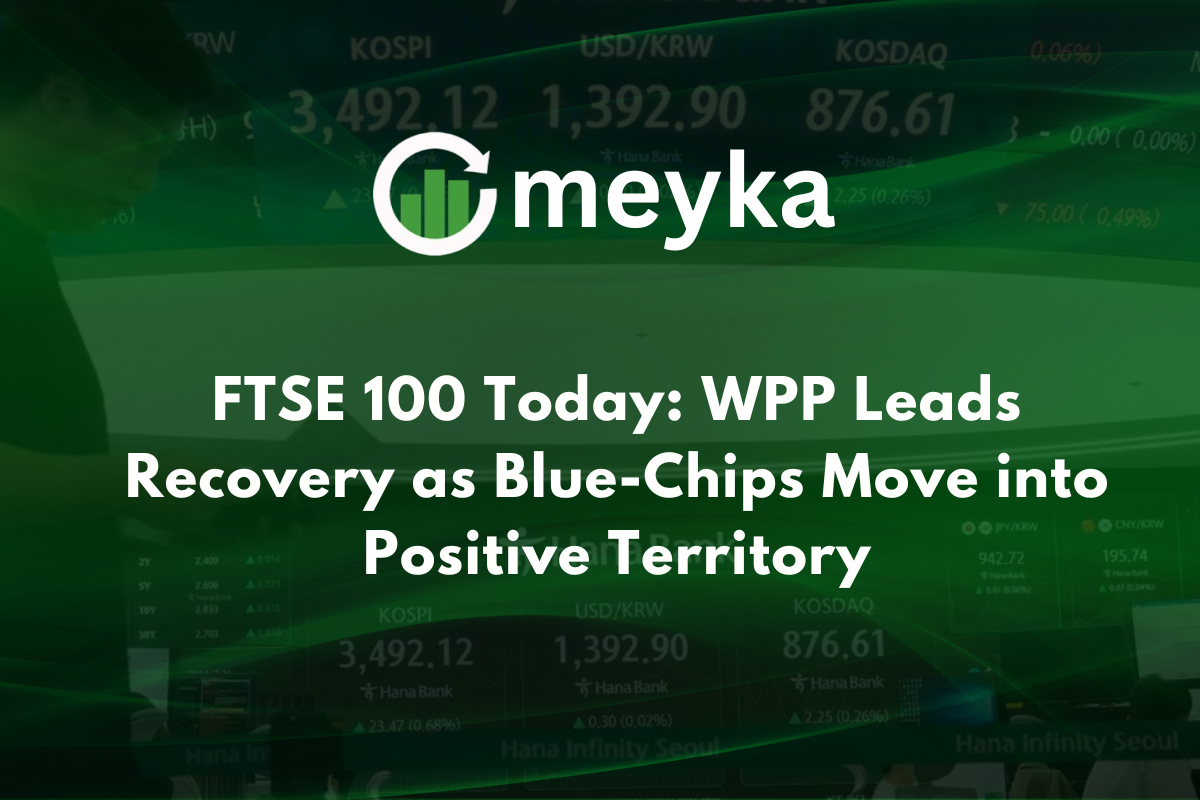FTSE 100 Today: WPP Leads Recovery as Blue-Chips Move into Positive Territory
The FTSE 100 (^FTSE) spent the session fighting off early weakness and finished in positive territory, with SSE among the strongest risers and sentiment around WPP helping to frame a broader recovery in UK blue chip shares after pressure from an Asian markets slump and a recent Wall Street tech rout.
FTSE 100 holds near record highs after early wobble
The London stock market started the day on the back foot. Futures for the FTSE 100 pointed to a small fall at the open, after two strong days when the index had already added more than two hundred and thirty points and moved close to the ten thousand mark.
As trading got under way, the benchmark slipped, with energy, miners and some retailers under pressure. At one stage the index was called about fifteen points lower, reflecting cautious mood after sharp losses in United States technology shares and a choppy session in Asia.
By late afternoon the picture looked very different. The FTSE 100 had climbed back and then pushed on to a fresh record close for the third day in a row, ending about eleven points higher around nine thousand nine hundred and eleven. Earlier in the day it had touched a new intraday peak above nine thousand nine hundred and thirty before easing a little.
Analyst Chris Beauchamp at IG said that even as tech stocks came under pressure on Wall Street, the London index managed to hold at the record level it set earlier in the day. In his view, this sits within a wider global recovery phase, with European markets also moving higher after recent volatility.
Why did the FTSE 100 bounce back today
The rebound was driven by buyers stepping in after early weakness. Heavy falls in Asian markets and the earlier Wall Street tech sell off had set a cautious tone, but bargain hunters used the dip to add exposure to big UK names. Strong company specific news from SSE and steady order news from BAE Systems helped support confidence and encouraged traders to look past the early red screens.
FTSE 100 and global risk mood after Wall Street tech rout
The backdrop for the London stock market was far from calm. A sharp Wall Street tech rout the previous session knocked risk sentiment around the globe. The Nasdaq index fell about 2 per cent, the S and P 500 lost more than 1 per cent and the Dow Jones also slipped, as investors took profits in big technology names that have led much of this year’s gains.
That slide in United States tech shares spilled into Asia. Tokyo’s Nikkei index dropped about 4.7 per cent by midday, its steepest fall in months, with semiconductor linked shares leading the move. In South Korea the Kospi fell around 3.7 per cent, with major chip makers under pressure as some of the recent enthusiasm around artificial intelligence related spending faded. Chinese markets fared a little better, but the mood across the region remained weak.
For London traders this meant a cautious start. Proactive and Investing together reported that spread betting firms expected the FTSE 100 to open modestly lower, and that Asian losses had clearly rattled sentiment in global equities.
How did Asian markets affect UK blue chip shares
The Asian slump did not trigger a full scale sell off in UK blue chip shares, but it did make investors more selective. Early in the session, cyclical names that are sensitive to global growth, such as miners and some industrial groups, lagged the wider index. As the day went on, stronger news from UK companies with clear domestic or European drivers helped the FTSE reduce and then erase those losses.
Some traders looking at AI Stock Analysis tools also noted that the recent rally in technology shares had been narrow and extreme, so rotation into sectors like utilities and defence looked more attractive on a relative basis.
FTSE 100 winners led by SSE and stand out blue chips
The clear star of the day was SSE, the power group that runs wind farms and electricity networks. The company set out a new five year investment plan worth about thirty three billion pounds, which it called a once in a generation chance to upgrade the United Kingdom power grid. Most of that spending, around twenty seven billion pounds, will go into transmission projects to move renewable power from the north of Scotland to homes and factories further south.
SSE said it expects this plan to more than treble its regulated asset base. It also set a target for adjusted earnings per share to reach between two hundred and twenty five and two hundred and fifty pence by the end of the period, implying compound annual growth in the high single digit range. Funding will come from a mix of cash flow, extra debt, hybrid capital, a planned equity raise and selected asset sales.
Investors liked the ambition. In early trade SSE shares jumped almost 12 per cent and by mid session they were up more than 15 per cent, making the group the top riser on the FTSE 100 and a key driver of the wider index move into the green.
WPP back in focus as bargain hunters circle
While SSE took the spotlight on this session, advertising giant WPP has also been an important part of the recent recovery story in UK blue chip shares. Proactive highlighted in separate coverage that WPP shares had recently jumped about 5 per cent as bargain hunters moved into what they saw as an oversold ad group, with one report suggesting the company was the subject of bid interest.
For traders following the index day by day, this kind of move in the WPP share price matters because it shows renewed appetite for cyclical and consumer facing names, not just for energy and defence stocks. Together with the strong performance from SSE and solid order news from BAE Systems, it suggests that rotation within the index is broadening out rather than staying tied only to one narrow theme.
What does this mean for everyday investors? For long term savers, the message is simple. The index can move from early losses to fresh records in a single day, driven by news from a handful of big companies. That is why many market watchers prefer steady exposure to the whole FTSE 100 rather than chasing one story at a time.
Sector moves, gilts and the wider UK picture
The recovery in the main index came even as some sectors lagged. Earlier in the day, communication services, consumer groups and real estate were a drag on performance. House builders such as Taylor Wimpey and retailers like Tesco and Marks and Spencer had been among the fallers, reflecting concern that tax changes in the upcoming Budget could weigh on home sales and household demand.
Even so, analysts noted that the FTSE 100 has shown resilience this year in the face of weaker growth and political noise. On a dollar basis the index is up more than 21 per cent over the year and more than 26 per cent on a currency adjusted basis, outpacing some peers and matching the performance of the tech focused Nasdaq over recent weeks.
Government bonds were another talking point. Gilts had seen a sharp reaction earlier in the year when rumours about policy changes swirled, but this time the move was more muted. Ten year gilt yields ticked up only a few basis points from near one year lows, even as reports of internal Labour party tensions in Downing Street circulated.
Later in the session, Proactive pointed to very strong demand for a new index linked gilt maturing in 2038. Orders reached about sixty nine billion pounds, a record for such an issue, even though the government sold just over four billion pounds of debt in the end. That appetite suggests investors still see value in UK inflation linked bonds, despite concerns about growth.
Social media and global interest in the FTSE 100
Market moves in London do not stay local. The combination of a Wall Street tech rout, an Asian markets slump and a fresh record in the FTSE 100 drew comments across trading desks and on social media.
Some traders also make use of screening tools and even AI Stock screeners to spot when indices like the FTSE 100 pull back from record highs and when large caps such as SSE, BAE Systems or WPP begin to attract dip buying interest. This blend of human judgement, company news and data led tools shows how modern markets knit together local stories and global flows.
Why do record highs not stop worries about risk? Record closes feel positive on the surface, but they do not wipe away risk. The same session that saw a fresh high for the FTSE 100 also came after a severe United States tech sell off, steep falls in Asian indices and ongoing questions about interest rates, government budgets and global growth.
What to watch in the next FTSE 100 session
Looking ahead, traders will keep a close eye on both domestic and global drivers. In the United Kingdom, attention turns to the Autumn Budget and what it might mean for consumer demand, housing and company taxes. Updates from retailers, home builders and banks will give further clues about how higher borrowing costs and changing fiscal plans are feeding through to the real economy.
Globally, investors will watch upcoming United States data on jobs, inflation and services activity, as well as comments from Federal Reserve officials, to judge when the next rate cut might arrive. Earnings from major American companies, including chip makers at the centre of the artificial intelligence trade, will also shape risk appetite after the recent tech rout.
For now, the story is that the FTSE 100 has managed to keep climbing, even as other markets wobble. The mix of strong corporate news from names such as SSE and ongoing interest in recovery candidates like WPP underlines that the index still offers a wide spread of global and domestic stories.
Anyone watching the next session will want to see if this pattern of early nerves and late dip buying continues, while remembering that no single session can guarantee what happens next and that stock picking, even with AI Stock research or other tools, always carries risk.
FAQs
The FTSE 100 recovered due to strong performances from key blue chip stocks like SSE and improved market sentiment. Early weakness from Asia and Wall Street faded as buyers stepped in.
WPP shares attracted bargain hunters after recent declines and reports of renewed investor interest. This boosted confidence across the advertising and media sector.
A sharp slump in Asian markets created early pressure on London stocks. However, the impact eased as UK corporate news helped shift sentiment.
SSE was the strongest performer after unveiling a major investment plan for electricity networks. Its double digit surge supported the entire index.
Disclaimer
The content shared by Meyka AI PTY LTD is solely for research and informational purposes. Meyka is not a financial advisory service, and the information provided should not be considered investment or trading advice.






